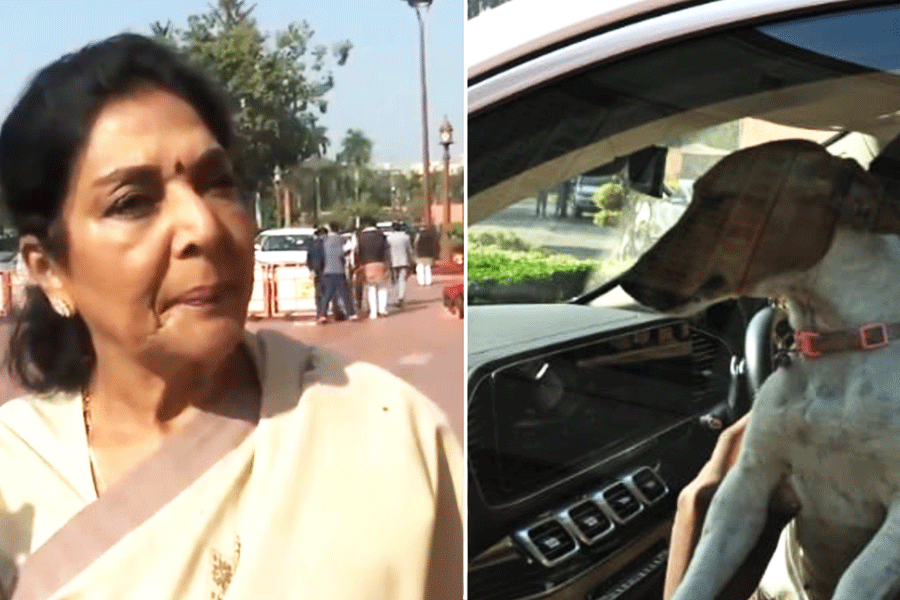.jpg)
Arjun Shreshta has never missed celebrating Dashain - Dussehra in Nepal - with his parents in Ramechhap, some 140km southeast of Kathmandu. But this year, for the first time, he stayed back in the Nepal capital.
The bus journey would have cost Shreshta, 27, almost four times the usual fare because of an acute fuel shortage. To top it, there were no seats because there were fewer buses, and he would have had to travel on the roof of a bus.
Shreshta is angry, and the anger is directed at Indian Prime Minister Narendra Modi. " Kya kar diya Modi saab ne? Nepal ka bura haal kar diya (what has Mr Modi done? He has wrecked Nepal)," he says.
Across Nepal, India is the talking point. From politicians to the media and the man on the street, almost everybody blames India for what they call an "undeclared blockade", leading to a fuel crisis and resulting in rising anger against a neighbour Nepal has always shared a love-hate relationship with.
Last year, people were lining the roads when Modi visited Nepal after becoming Prime Minister. Today, students are shouting anti-India slogans and burning Modi effigies.
"The wheel has turned full circle," says stand-up comedian Manoj Gajurel, who used to regale crowds with his "positive" impersonation of Modi.
Earlier this month, he changed his act by going to the Pashupatinath Temple, where Modi offered prayers in August last year. Gajurel offered a kshama puja - prayer for forgiveness - on behalf of Modi for "putting Nepal through hard times".
The times, indeed, are hard. Petrol is being sold at five times the price in the black market, cooking gas cylinders, which cost around Rs 1,000 (in Nepalese currency) till recently, now cost Rs 8,000-10,000. Some motorists say that they had to wait for a day at government pumps before they could buy rationed fuel.
The hardships hurt more because it's Dashain, the biggest festival of Nepal. This is also the best season for tourism, a lifeline for many Nepalis. But tourism has suffered because of skyrocketing prices, leading to cancellations. The loss to the Nepal economy because of the blockade is being pegged wildly at anywhere between USD 2 billion and 10 billion, depending on who one speaks to.
At the root of the problem is a new Constitution that came into effect on September 20, 2015. It led to massive protests by Madhesis and Tharus, Nepalese people living on the border areas of Bihar and Uttar Pradesh. Most people believe that India imposed the blockade because of the Constitution. India denies that, saying that fuel-bearing trucks from India have not been able to cross into Nepal because of street protests.
It is not in India's interests if the border with Nepal is in trouble, points out Ranjit Rae, India's ambassador to Nepal. "The solution to the current situation on the border lies within Nepal and it is for its leadership to resolve. It is not a blockade by India."
In Nepal, few buy that argument.
A story in Kathmandu goes that Nepal's latest set of problems with India began soon after leaders of four major political parties - the Nepali Congress, Unified Marxist Leninist, Unified Communist Party of Nepal (Maoist) and Madhesi People's Rights Forum Democratic - met on June, 8, 2015, to conclude a document. Called the "16-Point Agreement", it paved the way for a consensus on a Constitution, something that has been eluding Nepal for almost seven years.
A leader who attended the meeting says that the mobile phones of the assembled leaders started buzzing soon after it began. The calls and messages were from Lainchaur - the Indian embassy is called by its location by many Nepalis rather than its formal name. An Indian embassy official says he has no knowledge of this.
The leaders decided to switch off their phones. They then held discussions and reached an agreement. "We showed some backbone and that was not liked by Lainchaur and your ministry of external affairs," says the leader.
New Delhi wants proportional representation of Madhesis, Tharus and others in Parliament as promised in the interim Constitution. It wants these communities' representation in government structures to be increased and the formation of new states for the border people.
Nepal's Constituent Assembly which approved the new Constitution on September 17 did not take these into consideration. That was when S. Jaishankar, India's foreign secretary, went to Kathmandu as Modi's special envoy.
"By all accounts, Jaishankar was uncouth, brash and imperial in his behaviour towards Nepal's politicians," says Kathmandu-based political analyst Kanak Mani Dixit. "It left no doubt in anybody's mind that the orders had come from the Prime Minister to act tough. Otherwise Jaishankar is too sophisticated to resort to such things," Dixit says.
An Indian embassy official pooh-poohs the claim. Jaishankar, he says, was "professional and courteous" with the leaders he met. "The media in Kathmandu have always been critical of special envoys. No politician that Mr Jaishankar met has said anything negative about the meetings."
A great many rumours - or analyses - are doing the rounds of Kathmandu. Some say the Modi-led government was unhappy with Nepal declaring itself a "secular" republic despite being predominantly Hindu. Some argue that the border area is being kept "hot" because of Bihar elections. And there are others who hold that Indian intelligence agencies want an autonomous area for Madhesis so that it can act as a buffer against hill-based politicians in case they turn against India and grow closer to China.
.jpg)
All that is speculation, of course. The fact is Madhesis believe they are being sidelined. Under the new Constitution, Nepal's House of Representatives will have 275 members, of whom 165 will be directly elected from geographically determined constituencies and the rest by proportional representation. This means, the Madhesis, Tharus, Terai Dalits and others can be under-represented despite their numbers.
"These are clear violations of the interim Constitution that promised us seats and states according to our population," says Mahant Thakur, president of the Terai Madhes Loktantrik Party that is leading the protest. Madhesis, Tharus, Dalits, Muslims and others are estimated to comprise more than 50 per cent of Nepal's population.
"Like in India, there has been a political evolution in Nepal, and I think that process of change will not be easy. But it is for the leadership of Nepal to understand this change and we hope that the aspirations of all the people will be accommodated," ambassador Rae says.
Traditionally dominated by the hill Brahmins or Bahuns in politics and Kshatriyas (Chhetris) in the bureaucracy and judiciary, Nepali ruling formations are likely to continue even under the new Constitution. "There is no doubt that the new Constitution was worked out so that it doesn't threaten the hold of traditional hill-based social groups," opines Nepal expert S.D. Muni, professor emeritus, Jawaharlal Nehru University, Delhi.
Some Nepali politicians disagree. "Our President, Vice-President, deputy speaker and chief justice are all from Madhes. As we progress, we will have more people in important positions," says Rajan Bhattarai, member of Parliament and adviser to Prime Minister K.P. Oli on foreign affairs.
These posts, Madhesis counter, are mostly ceremonial. "We will never get positions of strength," laments Pradeep Yadav, Madhesi Jan-Adhikar Forum leader in Birgunj. "We will continue to languish and hill people will continue to mock us, calling us 'dhotis,' 'Biharis' and 'Indian agents'," he says.
India has been drawn into this clash, as the blockade has affected the people like never before. The last embargo India imposed on Nepal was in 1989-90. Speculation did the rounds then, too. India cited Nepal's attempts to buy anti-aircraft guns from China as the reason for stopping transit trade.
But this time's economic hardship has caused a tsunami of anger. "India officially may not call it a blockade. But it smells like a blockade, it feels like a blockade and sounds like a blockade," says Dixit.
But while Nepal may love or hate India, it certainly can't ignore it. Indian investments in Nepal run into billions of dollars. Nepal imports almost 70 per cent of its needs through India. And almost all its fuel and cooking gas is routed through checkpoints between India and Nepal, the largest being Birgunj, near Raxaul in Bihar, where the protests were mostly held.
"Even a child can make out that it is a deliberate blockade," scoffs Kathmandu-based political analyst Amit Dhakal. "Birgunj is not the only checkpoint. India could have routed supplies through other points - Biratnagar, Bhairahawa, Krishnanagar and Nepalgunj," he says.
Scarcity of fuel has fanned other protests - with student groups out on the streets. "The new generation of Nepalese can go without fuel for months but we are not ready to bend before India," says Kishor Bikram Malla, a student leader of the student wing of the CPN (UML).
Did India misread the situation? "Nepali nationalism often takes an anti-Indian colour, especially when the internal political differences in Nepal grow. This is not a new phenomenon and we should have seen this coming," former ambassador to Nepal Rakesh Sood says. There was a "clear change in the perception" between Modi's August visit and when he visited Nepal for a regional summit last November, he says.
Perhaps New Delhi is now ready to extend an olive branch. "We as a larger neighbour should be conscious of the sensitivities of smaller neighbours," Rae says.
For Shrestha, that's cold comfort. "I will never forgive or forget what India has done to me," he says.

.jpg)








